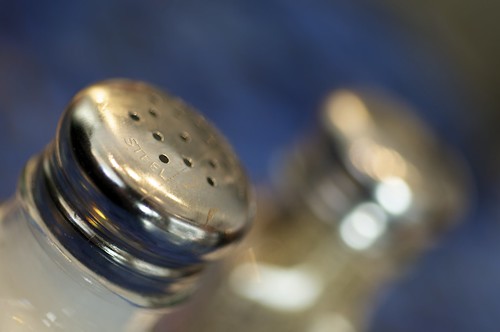
![]() photo credit: Nick Harris1
photo credit: Nick Harris1
Last week, the Weston A. Price Foundation issued a press release, FDA Warned on Dangers of Salt Restriction. Someone who read the press release sent me this question. Note: as a consumer, I have trouble digesting information in grams, so I have converted grams to teaspoons in parentheses!
Question Regarding Salt Intake
Q: I was wondering if Sally Fallon has researched the average intake of sodium in America? It seems to me that with all the processed food that many people consume now a days, there may indeed be an over consumption of salt. Is there any validity to this? Surely too much sodium in the diet is troublesome to human health. I certainly do not promote the intake of artificial salt however!
Angelle, from Canada
Answer from Sally Fallon Morell, President, Weston A. Price Foundation
We will be having an article in the upcoming Wise Traditions journal on salt that addresses this subject. The article will be by Dr. Morton Satin, based on his presentation at our 2011 International Wise Traditions conference. If I remember correctly, the current daily consumption is about 9 grams (1-1/2 teaspoons) on average. This is just slightly higher that the absolute minimum that we need. By looking at the food records from the armed services in the past, they have been able to determine that before refrigeration, consumption of salt averaged 18 grams (roughly 3 teaspoons) per day-about double what we are eating now, even with all the processed food, and with no obvious adverse effects. I would say that adequate intake of salt, by everyone, is one of the good things about the modern diet. Best, Sally
Answer from Morton Satin of the Salt Institute
Yes, our consumption prior to the ‘50s was around 18 grams salt (almost 3 teaspoons) per day because salt was the primary means of food preservation. As refrigeration quickly took over that function after WWII, by the end of the 50s, our consumption dropped to approximately 9 grams (1-1/2 teaspoons) of salt per day and has remained there ever since.
I know that there is the intuitive sense that our increase in processed foods consumption has resulted in an increase in overall salt intake, but that is not what the actual evidence says. It appears that as salt in processed food varies, we adjust for these variances in the voluntary use of table salt. It is a testament to the ‘wisdom of the body.’ And, in fact, the latest study (JAMA Dec 2011) by O’Donnel et shows the dose-response curve and indicates that the area of lowest risk to negative health outcomes is between 9 and 18 grams of salt (equivalent to 3,450 – 7,000 mg sodium per day, or between 1-1/2 to 3 teaspoons salt daily). Anything below or above that range poses a much higher risk to health.
In the case of the Dietary Guidelines, the range of 1,500– 2,300 mg (2/3 to 1 teaspoon, according to Morton Satin) sodium per day places us right in the middle of the danger zone. At the upper limit, anything above 18 grams of salt (7,000 mg sodium, or nearly 4 teaspoons) per day is too salty for the average person’s taste.
Kimberly Hartke is the publicist for the Weston A. Price Foundation, a nutrition education non-profit, based in Washington, D.C. See also, the health benefits and uses of salt on the Salt Institute website.
If you are looking for a good source of salt for your family, please check out Salt and Spices on our Resources page for highly recommended vendors.
Shocked? To delve deeper, watch on video, Morton Satin’s criticism of the 2010 USDA Dietary Guidelines on salt:
If you found this eye-opening, please share this post with a friend!-Kimberly


What about eating only sea salt without iodine -are we at risk for thyroid issues?
Thanks! Guess I am doing something right. I now consume gray Celtic sea salt, because it is rich with minerals. I have given up on salt shakers, and add by the pinch. The granules are kinda big and rough, so I get a real “salt pop” every time I crunch into a granule.
@Jennifer this is a question that I have, also. I will work on this and try and put another Q&A post up with your answer!
By the way, everyone, I am starting a Q&A page on my menu, it can be found under BEST BLOGS on the drop down menu.
Here is the link:
http://hartkeisonline.com/best-blogs/questions-and-answers/
I will index all of the past Q&A posts, so they are easy to find!
Jack, you can buy a ceramic salt grinder from Selina Naturally, which is made for grinding gray Celtic Salt. It works very well, and one of the most common sounds at our dinner table is the sound of salt crunching through the grinder as we grind it directly over our food..
I LOVE my pink Himalayan salt!
Folks, I made a few errors in my grams to teaspoons conversions. Morton Satin reviewed my work, and he has helped me update and correct these figures. Sorry for any confusion.
Here is details of a study saying that even if you have heart problems, in overall terms a low salt diet is not healthy.
http://www.abc.net.au/radionational/programs/healthreport/facts-about-salt/3305370#transcript